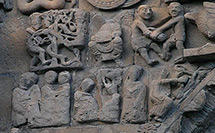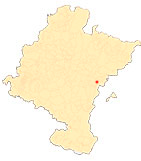The Gateway of Santa María de Sangüesa
By Clara Fernández-Ladreda Aguadé
|
THE ARTISTS. THE WORKSHOP OF SAN JUAN DE LA PEÑA AND THE WORKSHOP OF SCHEMATIC FIGURES |
|
Spandrels and buttresses
The problem of the archivolts is even more pronounced: the lack of a well-structured and unique programme, so that one can only speak of thematic groups, a disorderly and arbitrary distribution, and difficulties in identifying the figures and scenes, which has led to different interpretations.
The biblical themes, taken interchangeably from the Old Testament, the New Testament and the Apocalypse, are prominent.
From the Old Testament we find the Original Sin (Genesis 3, 1-6) in the left spandrel. From the Apocalypse we find the Tetramorphos, that is, the four living creatures mentioned by Saint John as part of the escort that accompanies the supreme judge in his coming at the end of time to judge humanity (Rev. 4, 6-8) and described as a lion, an eagle, a bull and a winged man, traditionally associated with the four evangelists, distributed between the two spandrels.
From the New Testament we can see a relatively extensive cycle of the Infancy of Christ, of which the episodes of the Dream of Saint Joseph (Mt. 1, 18-24), the visitof the Virgin to her cousin Saint Elizabeth (Lk. 1, 39-56) and the Annunciation (Lk. 1, 26-34), on the left-hand side, can be recognised with some clarity. Particularly interesting is the Annunciation, a synthesis of this and the Coronation, also including the detail of the kneeling archangel Gabriel, due to the novelty of such iconography, as the work from Sangües would be coeval with the relief of the pillar of the cloister of the monastery of Silos (ca. 1160), which until now had been considered the first example at a general level, and prior to the capital of the doorway of San Miguel de Estella (1170-1180), considered until now to be the first case in Navarre.
On the margins of this cycle are two scenes located on the right buttress. The first would be the parable of the foolish virgins and the wise virgins (Mt. 25:1-13), a prefiguration of the Last Judgement developed in the tympanum. The second is the hypothetical submissionof the Law or Traditio legis - either the Old Law, i.e. the Ten Commandments, given to Moses by God (Exodus 20:1-17), or the New Law, the commandment of love, given to the apostles by Jesus (Jn. 13:34) - which again could be related to the juridical function of the title page.
The other themes generally coincide with those of the archivolts. Thus, we find several representations of trades: a blacksmith, a pair of shoemakers, an ivory carver, etc. A good issueof warriors - on horseback or on foot, isolated or facing each other or monsters - among which the knight riding a giant on the left spandrel and the two almost identical fighters on foot on the right spandrel stand out, one of them drawing a sword and the other thrusting it into the throat of a dragon, traditionally and erroneously associated with the hero of the Norse sagas, Sigurd. The figures of sins, all of them located on the left-hand side: lust, represented by the typical woman attacked by reptiles and toads and another female in an exhibitionist attitude, and anger, embodied by two wrestlers who fight with bare hands. Juggler themes, located in the same enjuta, which should be connected with the previous ones, among which the acrobat inside the hoop stands out. Men and women. Animals, both real - goats, birds, dogs, lions, a deer chased by a wolf - and fantastic - basilisks, dragons, griffins, harpies. And ornamental elements, among which the interlacing stands out. Both the latter and the animals seem to be mainly decorative in nature.












